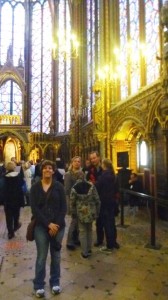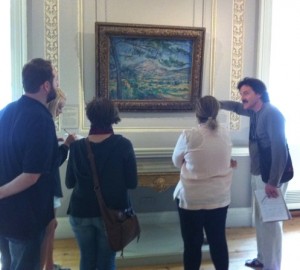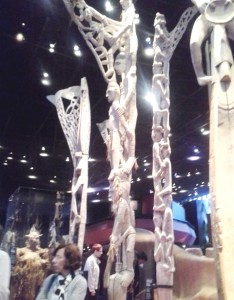Emily Prichard ’16 traveled to London and Paris during the summer as part of a short-term study abroad trip, led by art faculty Dr. Jeffrey Collins and Professor Loehle. Students explored and studied these cities as the settings for artistic and architectural revolutions. Here are some of Emily’s experiences in her own words.

Emily in the Sainte-Chapelle cathedral in Paris.
This trip to London and Paris compounded my passion for art; I can’t think of a career for myself that doesn’t involve art.
This was partly inspired by the atmosphere of purity and wonder that art can offer; art, in all its forms seemed to transform its environment into a sacred, treasured space.
One of the best examples of this transformation was Sainte-Chapelle in Paris, France. The entire second story of the cathedral was floor-to-ceiling stained glass windows. Even though I had prepared a report on this cathedral, I was still incredibly blown away by the atmosphere, how the colors and light transformed a relatively tiny cathedral. With sunlight shining through the window panes, it felt as though the cathedral was a divine, living painting that the group had the privilege of experiencing from the inside: in a way, it felt like our tour group was literally inside the scene of a painting, only to realize it for a living organism. To personally see the mastery of detail involved to create each tiny scene was the equivalent to standing next to an expansive ocean: it gave one the feeling of not only being extremely small in comparison, but being somehow connected just by recognizing the true beauty and purity of the object. Sainte-Chapelle held beauty, purity, and color that can only be truly understood if experienced; even all of the research prior to Paris had not quite prepared me (or the rest of the group) for the atmosphere of the cathedral.

Dr. Collins (right) talks to students about Cezanne at the Courtauld Gallery in London.
One of my most favorite museums out of the entire trip was the Quai Branly Museum in Paris, France. Focusing entirely on ancient and oceanic artifacts, this museum invoked a sense of wonder and mystery in the same way that Sainte-Chapelle invoked beauty and purity. My favorite aspect of the museum is the fact that these artifacts are so appreciated, even though archeologists still don’t know the meaning or purpose behind several of the objects. Therefore, the objects give off an air of mystery, inviting the viewer to wonder, to imagine themselves several thousand years ago, crafting what they see in the present. I was personally struck by the eerie feeling of a few; it felt as though these pieces were intended for rituals, or for people (or spirits) of great power, that we were somehow intruding. This museum felt like a giant time capsule, the modern design failing to exhaust a feeling of stepping back into a lost era. While Sainte-Chapelle helped me to rediscover the purity of art, Quai Branly helped to create the idea of art sometimes becoming a separate entity all its own, significance defined by the synesthesia of the viewer.

A scene from the Quai Branly Museum in Paris.
Another important impact of this trip was realizing the general appreciation that Europe and the United Kingdom seem to have for art. The crowds in each museum and cathedral were VERY different than American museums/historic places. The average American seems to care less about the meaning or purpose of the piece; unless somewhat studied in art, they see museums as places for their amusement on rainy days. In Paris and London, the people treated museums as places of learning and interest, and were generally somewhat knowledgeable about what they were looking at. For example, nearly every museum had a group of schoolchildren touring; they were not rowdy, but actually listened to and absorbed the lectures. I loved this culture shock because it showcased the idea of using free museums as a means of education, for schoolchildren and adults alike. The museums were treated with respect, and the viewers seemed to have actually learned something by the time they left. This cultural difference gave me hope, that fine art can be appreciated and valued even in an age of technology and digital media.
Not coincidentally, Emily changed her major to Studio Art, with a minor in Art History.
